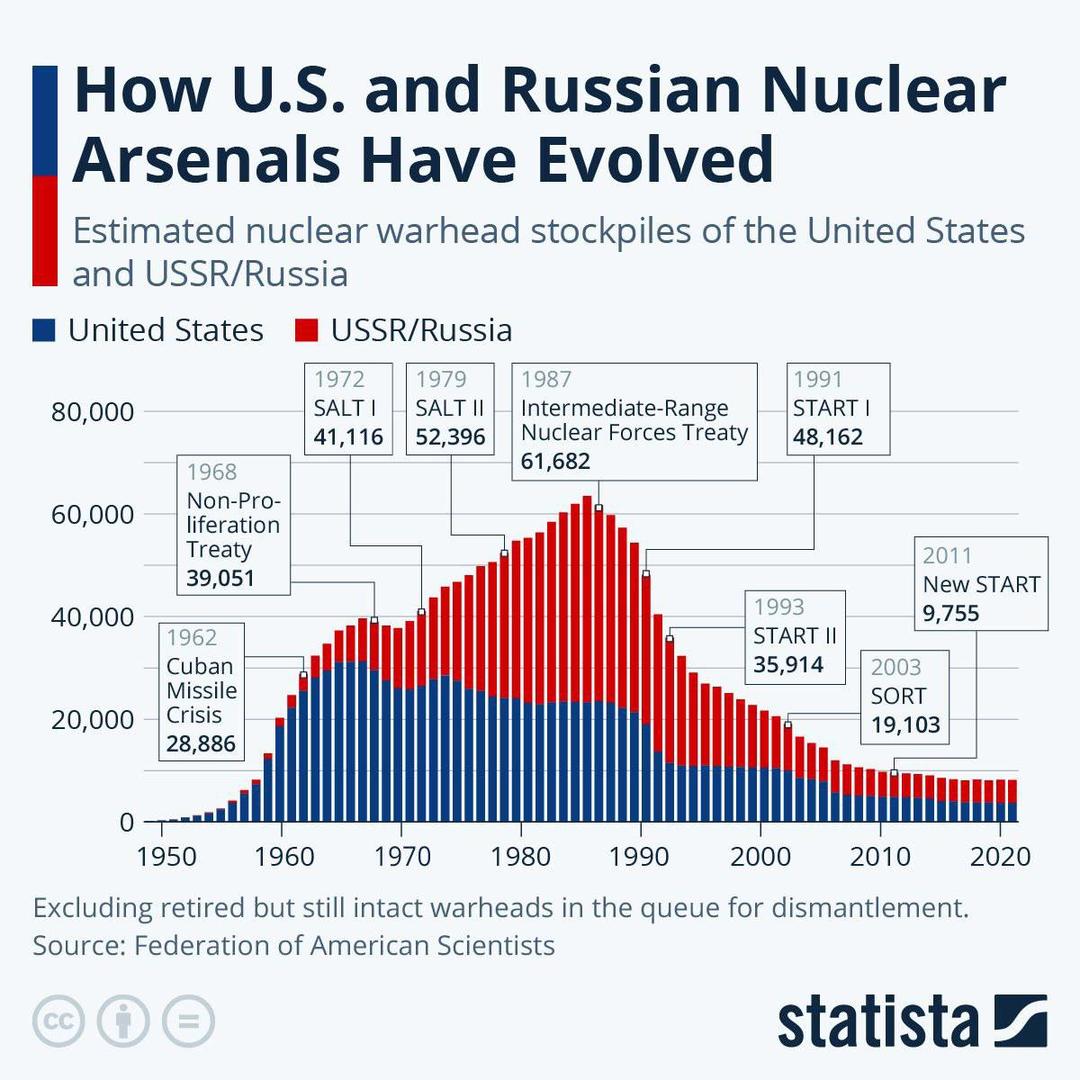
US Russia Nuclear Arsenals / Statista
Russia’s president Vladimir Putin announced last week that Moscow was suspending participation in the New Strategic Arms Reduction Treaty (“New START”), a pact signed with the United States in 2010, which put limits on the number of strategic nuclear warheads.
US Secretary of State Antony Blinken responded that Russia’s announcement was “deeply unfortunate and irresponsible.”
It’s an interesting scenario because the treaty makes no allowance for “suspension”. Article XIV, Section 3 notes:
Each Party shall, in exercising its national sovereignty, have the right to withdraw from this Treaty if it decides that extraordinary events related to the subject matter of this Treaty have jeopardized its supreme interests. It shall give notice of its decision to the other Party. Such notice shall contain a statement of the extraordinary events the notifying Party regards as having jeopardized its supreme interests. This Treaty shall terminate three months from the date of receipt by the other Party of the aforementioned notice, unless the notice specifies a later date.But unilateral withdrawal from such agreements has been a regular feature on the part of the United States. Here are the ten agreements over the years between the US and USSR/Russia and how they have panned out:
- Partial Test Ban Treaty (1963): This treaty prohibited the testing of nuclear weapons in the atmosphere, underwater, or in outer space.
- Anti-Ballistic Missile Treaty (1972): This treaty limited the deployment of defensive ballistic missile systems to protect each country's territory. Both countries agreed to only have one ABM deployment area, and it was limited to 100 launchers per country. In 2022, the US unilaterally withdrew from this treaty.
- Strategic Arms Limitation Talks I (1972): This agreement focused on limiting the number of intercontinental ballistic missiles (ICBMs) and submarine-launched ballistic missiles (SLBMs) that each country could have.
- Strategic Arms Limitation Talks II (1979): This treaty limited the number of strategic offensive arms that each country could have. It also established the Standing Consultative Commission to facilitate communication between the two countries.
- Intermediate-Range Nuclear Forces Treaty (1987): This treaty eliminated all ground-launched ballistic and cruise missiles with ranges between 500 and 5,500 kilometers.
- Strategic Arms Reduction Treaty I (1991): This treaty called for the reduction of strategic nuclear arms, including ICBMs, SLBMs, and heavy bombers. In 2019, the US unilaterally withdrew from this treaty.
- Strategic Arms Reduction Treaty II (1993): This treaty called for the continuation of the reductions started in START I, with further reductions in the number of nuclear warheads and delivery vehicles.
- Comprehensive Nuclear-Test-Ban Treaty (1996): This treaty bans all nuclear explosions, including those conducted underground. Although both the US and Russia signed the treaty, it has not yet entered into force due to some countries, including the US, not ratifying it.
- Strategic Offensive Reductions Treaty (2002): This treaty, also known as the Moscow Treaty, called for the reduction of strategic nuclear warheads by both countries. It did not include verification measures.
- New START (2010): This treaty called for further reductions in strategic nuclear arms, including ICBMs, SLBMs, and heavy bombers. It also included verification measures to ensure compliance. In February 2022, the US unilaterally suspended arms control talks with Russia
My view is that New START is irrelevant. Firstly, it does not limit the nuclear arsenals of US allies France and United Kingdom. Secondly, it fails to take into account Russian technological advances such as submarine-launched missiles.
It’s also my view that whether there are 300 or 3 000 or 30 000 nuclear warheads on each side makes no difference — there’s no winner in a nuclear war.
